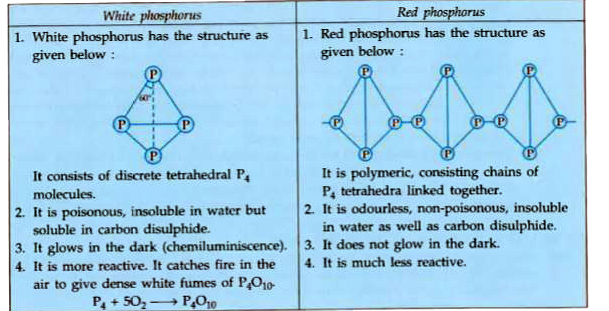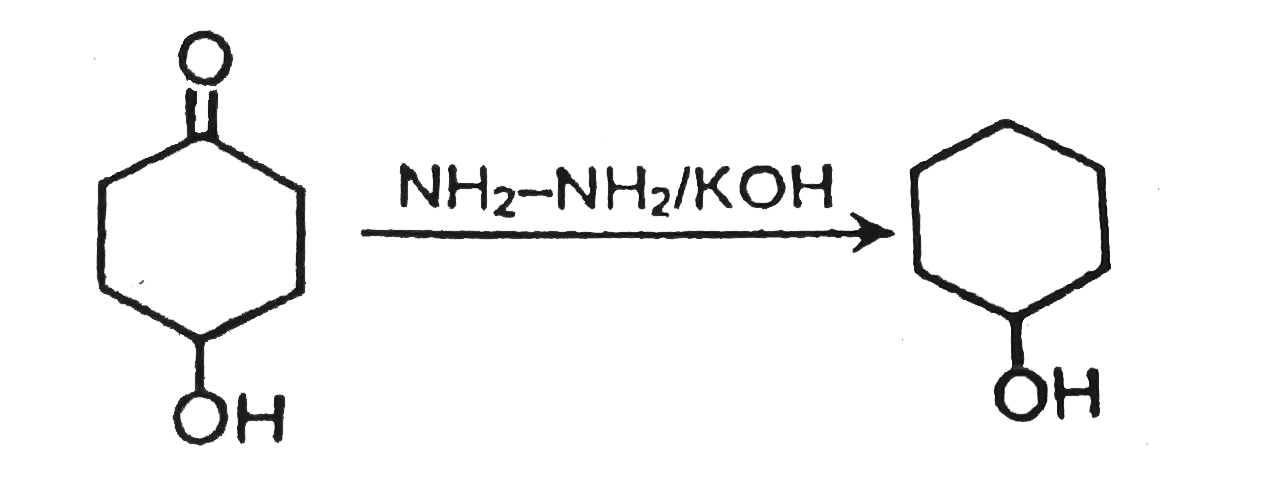InterviewSolution
This section includes InterviewSolutions, each offering curated multiple-choice questions to sharpen your knowledge and support exam preparation. Choose a topic below to get started.
| 10451. |
Write the possible isomers for the formula (i) C_2H_6O (ii) C_3H_8O |
|
Answer» SOLUTION :(i) `C_2H_6O` `{:((a)CH_3-CH_2OH:"Ethanol"),((b)CH_3-O-CH_3:"METHOXY metahane"):}}{:("Functional "),("ISOMERISM "):}` (ii) `C_3H_8O` (a) `CH_3 - CH_2 - CH_2 OH` : Propan - 1 - ol (b) `CH_3- underset(OH)underset(|)(CH) - CH_3`: Propan - 2- ol (iii) `CH_3 - CH_2 -O - CH_3` :Methoxy ethane (a) and (b) - Position isomerism (a) and (C ) - Functional isomerism |
|
| 10452. |
What are transition elements ? Write two characteristics of the transition elements. |
|
Answer» Solution :MIDDLE portion of the periodic table FLANKED by s- and p-block constitutes transition elements. These are the elements in which filling of electrons takes PLACE in the d-orbitals. TWO characteristics : 1. They form coloured ions. 2. They form complex compounds. |
|
| 10453. |
Which of the following gives acetylene on hydrolysis ? |
|
Answer» `Al_(2)(C_(2))_(3)` |
|
| 10454. |
Which one of the following reactions cannot occur ? |
|
Answer» `Cu+ ZnSO_4 RARR CuSO_4 + Zn DARR ` |
|
| 10455. |
Which one of the following statement(s) is/are false ? |
|
Answer» Weak LIGANDS like `F^(-),Cl^(-)" and "OH^(-)` usually FORM low spin COMPLEXES. |
|
| 10456. |
What is the formula of density (d) of unit cell ? |
| Answer» Solution :`Density(d)=("Mass of UNIT CELL")/("VOLUME of unit cell")=(ZM)/(a^3N_A)` | |
| 10457. |
Which of the following is an example of zwitterion : |
|
Answer» Urea |
|
| 10458. |
The standard reduction electrode potentials of the three electrodes P,Q and R are respectively -1.76V, 0.34V and 0.8V. Then |
|
Answer» Metal Q will displace the cation of P from its aqueous SOLUTION and deposit the metal P |
|
| 10459. |
What is the equilibrium expression for the reaction: P_4(s)+5O_2(g) hArr P_4O_10(s) |
|
Answer» `K = [O_2]^5` |
|
| 10460. |
The scientific and technological process used for the extraction/isolation of the metal from its ore is called as metallurgy.Following information is given in columns. Column-I:Metal Column-II:Process desirable in metallurgy Column-III: Main reduction process involved in metallurgy Answer the following three questions by appropriately matching the information given in the three column of the above following table. For Ag the only correct combination is : |
|
Answer» (III)(iii)(R) |
|
| 10461. |
Tollen's reagent is used for the detection of aldehyde. When a solution of AgNO_(3) is added to glucose with NH_(4)OH, then gluconic acid is formed. Ag^(+)toe^(-)toAg,E_(red)^(@)=0.8V C_(6)H_(12)O_(6)+H_(2)OtoC_(6)H_(12)O_(7) (Gluconic acid) +2H^(+)+2e^(-),E_(oxd)^(@)=-0.05V Ag(NH_(3))_(2)^(+)+e^(-)toAg(s)+2NH_(3),E^(@)=-0.337V [Use 2.303xx(RT)/(F)=0.0592 and (F)/(RT)=38.92 at 298K] Now answer the following three questions: Q. 2Ag^(+)+C_(6)H_(12)O_(6)+H_(2)Oto2Ag(s)+C_(6)H_(12)O_(7)+2H^(+) Find in K of this reaction: |
|
Answer» 66.13 `0=0.75-(0.0592)/92)LOGK`. in `K=2.303xxlogK=2.303xx25.34=58.38` |
|
| 10462. |
The scientific and technological process used for the extraction/isolation of the metal from its ore is called as metallurgy.Following information is given in columns. Column-I:Metal Column-II:Process desirable in metallurgy Column-III: Main reduction process involved in metallurgy Answer the following three questions by appropriately matching the information given in the three column of the above following table. For Cu the only incorrect combination is : |
| Answer» Solution :NA | |
| 10463. |
The scientific and technological process used for the extraction/isolation of the metal from its ore is called as metallurgy.Following information is given in columns. Column-I:Metal Column-II:Process desirable in metallurgy Column-III: Main reduction process involved in metallurgy Answer the following three questions by appropriately matching the information given in the three column of the above following table. Select the only incorrect combination. |
|
Answer» (I)(II)(P) |
|
| 10464. |
Tollen's reagent is used for the detection of aldehyde. When a solution of AgNO_(3) is added to glucose with NH_(4)OH, then gluconic acid is formed. Ag^(+)toe^(-)toAg,E_(red)^(@)=0.8V C_(6)H_(12)O_(6)+H_(2)OtoC_(6)H_(12)O_(7) (Gluconic acid) +2H^(+)+2e^(-),E_(oxd)^(@)=-0.05V Ag(NH_(3))_(2)^(+)+e^(-)toAg(s)+2NH_(3),E^(@)=-0.337V [Use 2.303xx(RT)/(F)=0.0592 and (F)/(RT)=38.92 at 298K] Now answer the following three questions: Q. When ammonia is added to the solution, pH is raised to 11. Which half-cell reaction is affected by pH and by how much: |
|
Answer» `E_(oxd)` will INCREASE by a FACTOR of 0.65 for `E_(oxd)^(@)` `E_("oxide")=-0.05-(0.591)/(2)log(10^(-11))^(2)=-0.05+0.65` or `triangleH=0.65` volt. |
|
| 10465. |
What are the different furnaces used for extraction of metals? |
|
Answer» SOLUTION : Different furnaces used for the extraction of metals are : (1) Reverberatory FURNACE (2) Bessemer converter (3) Blast furnace (4) HEARTH. |
|
| 10466. |
Which possesses tetrahedral shape(sp^3-hybridisation of central atom): |
|
Answer» `[ZN(NH_3)_4]^(2+)` |
|
| 10467. |
Which of the following is animal polysaccharide? |
|
Answer» Amylopectin |
|
| 10468. |
To an acidicsolution of aniona few drops of acidified KMnO_(4) are added. Which one of the following anions , if present wil not decolourise the KMnO_(4) solutions ? |
|
Answer» `I^(-)` `2MnO_(4)^(-) + 16H^(+) + 10X^(-) to 2MN^(2+) + 8H_(2)O +M 5X_(2) (X^(-) = Cl^(-) , I^(-))` `2MnO_(4)^(-) + 16H^(+) + 5S^(2-) to 2Mm^(2+) +8 H_(2)O + 5S` `2MnO_(4)^(-) + 6H^(+)+ 5NO_(2)^(-) to 2Mn^(2+) + 3H_(2)O + 3H_(2)O + 5NO_(3)^(-)` |
|
| 10469. |
Which of the following is ambidentate group ? |
| Answer» SOLUTION :`NO_(2)` is ambidentatenucleophile becauseithas twoattackingcentre. It canattackon substancethrough nitrogenor OXYGEN. | |
| 10470. |
What is the role of zinc metal in the extraction of silver? |
|
Answer» SOLUTION :Zn ACTS as a reduction agent. `2[AG(CN)_(2)]^(-) (AQ) +Zn (s) to Ag (s) +[Zn(CN)_(4)]^(2-) (aq)`. |
|
| 10471. |
Which of the following is not formed as an inter mediate in the Reimer- Tiemann reaction between phenol and alkaline chloroform? |
|
Answer»
|
|
| 10472. |
Which of the following is not correct for noble gas? |
|
Answer» Ar is used in ELECTRIC bulbs |
|
| 10473. |
The specific conductance of a 0.01 M solution of KCl is "0.0014 ohm"^(-1)" cm"^(-1) at 25^(@)C. Its equivalent conductance is ............... |
|
Answer» `14" "ohm^(-1)CM^(2)EQ^(-1)` |
|
| 10474. |
What productswould be formed when a nucleotide from DNA containing thymine is hydrolysed ? |
| Answer» SOLUTION :Besides thymine , the TWO other PRODUCTS , are :2 deoxy-D-ribose and phosphoric ACID. | |
| 10475. |
Which of the following shows variation of bond energy (BE) of halogens |
|
Answer»
|
|
| 10476. |
The specles that do not contain peroxlde lons are |
|
Answer» `PbO_(2)` |
|
| 10477. |
What is the No. of isomers with pyridine nucleus possible for compounds having MFC_(7)H_(9)N? |
Answer» 
|
|
| 10478. |
Which of the following structures permits cis-trans isomerism ? |
| Answer» Answer :D | |
| 10479. |
Which one of the following sets of monosaccharides forms sucrose |
|
Answer» `ALPHA`-D-Galactopyranose and `alpha`-D-Glucopyranose |
|
| 10480. |
Which of the following is most reactive toward S_N Ar? |
|
Answer»
|
|
| 10481. |
What are all the conditions are necessary form catenation? |
|
Answer» SOLUTION :Essential condition for catenation, (i) the VALENCY of element is greater than or equal to TWO. (ii) Element should have an ABILITY to bond with itself. (iii) The self bondmust be as STRONG as its bodn with other elements. (iv) Kinetic inertness of catenated compound towards other molecules. |
|
| 10482. |
Which is not correctly matched? |
|
Answer» (C) BIS (henzoyl acetaonate)beryllium(II) (d) Tetrachloroauric(III) acid. |
|
| 10483. |
Which of the following substance can be used directly as fertilizer? |
|
Answer» `(NH_(4))_(2)SO_(4)` |
|
| 10484. |
Three metals A B and C have work functions as 15.5eV, 24eV and 30.5 eV respectively. If the light of wavelength 500Å is incident of each metal, which of the following is correct? |
|
Answer» Electrons can be ejected from A and C only |
|
| 10485. |
Which of the following acids acts as reducing agent : |
|
Answer» HOOC -- COOH |
|
| 10486. |
What current strength in amperes will be required to liberate 10 g of iodine from potassium iodide solution in one hour ? |
|
Answer» SOLUTION : `=(96,500)/(127)xx"10 COLUMB"` LET the CURRENT strength be = I Time in seconds `=1xx60xx60` We KNOW that the quantity of electricity, Q, used is given by the expression `Q=Ixx" time in seconds"` Curernt strength, `I=(Q)/(t)=(96,500xx10)/(127xx60xx60)` = 2.11 ampere. |
|
| 10487. |
Write the electronic configurations of the elements with atomic numbers 61, 91, 101 and 109. |
|
Answer» Solution :Z = 61 (Promethium, PM), Electronic configuration : `[Xe]^(54)4f^(5)5d^(0)6S^(2)`. Z = 91 (Protactium, Pa), Electronic configuration : `[RN]^(86)5f^(2)6d^(1)7s^(2)`. Z = 101 (Mendelevium, Md), Electronic configuration : `[Rn]^(86)5f^(13)6d^(0)7s^(2)` Z = 109 (Meitnerium, Mt), Electronic configuration : `[Rn]^(86)5f^(14)6d^(7)7s^(2)`. |
|
| 10488. |
Two moles of acetic acid are heated with P_(2)O_(5). The product formed is |
|
Answer» ACETIC anhydride |
|
| 10489. |
Which of the following is correct method of preparation of methyl fluoride? |
|
Answer» `CH_3Br+ AGF to ` |
|
| 10490. |
When ethyl acetate was hydrolysed in pressure of 0.1 N HCI, the rate constant was found to be 5.40 xx 10^(-5) sec^(-1).But when 0.1 N H_2SO_4 was used for hydrolysis, the rate constant was found to be 6.25 xx10^(-5)sec^(-1).Thus, it may be concluded that : |
|
Answer» `H_2SO_4`is STRONGER than HCI `=("rate CONSTANT of reaction catalysed by "H_2SO_4)/("rate constant of reaction catalysed by HCl")` |
|
| 10491. |
Write main differences between the properties of white phosphorus and red phosphorus. |
Answer» Solution : DIFFERENCES between properties of white and RED PHOSPHORUS: 
|
|
| 10492. |
Which compound will liberate CO_2 from NaHCO_3 solution : |
|
Answer» `CH_3CONH_2` |
|
| 10493. |
Whichforms maximu compunds with Xenon |
|
Answer» F |
|
| 10494. |
What is the correct combination for the reaction : |
|
Answer» (III)(iv)(S)  This is Wolff Kishner reduction, so base SENSITIVE GROUPS should not be PRESENT in the reactant |
|
| 10495. |
Write suitable reagent used for the following conversion: CH_3-CH_2-OH rarr CH_3-CH_2-O-CH_2-CH_3 |
| Answer» SOLUTION :CON.`H_2SO_4//413K` | |
| 10498. |
Which of the following anion(s) is/are interferingradicate ? |
| Answer» Answer :a,b,c | |
| 10499. |
Which of the following expression is not applicable on the hydrolysis equilibrium :CN^(-)H_(2)OrArrHCN+OH^(-) |
|
Answer» `K_(h)=(K_(w))/(K_(a(HCN)))` |
|
| 10500. |
Which of the following does not give Borax bead test ? |
|
Answer» CHROMIUM salt |
|